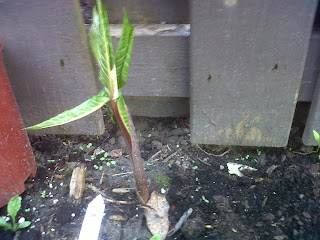The good about it is the flora and fauna, right in my very own backyard - ostrich ferns, trout lilies, white trilliums, red trilliums. they are just by the fence, probably escaping from the blades of the lawnmowing guys.
Today, May 14th 2012, a day after mothers day, i saw them blooming - well maybe couple of days now, but I did not notice. The wiki facts are listed below and here are the pictures I've taken this morning.
 |
| may 14, 2012 - white and red trillium |
 |
| may 14, 2012 a white trillium |
ttp://en.wikipedia.org/wiki/Trillium_erectum
 |
| may 14, 2012 - a red trillium with white trillium |
Trillium erectum, also known as Wake-robin, red trillium, purple trillium, Beth root or Stinking Benjamin,[2] is a spring-flowering perennial plant native to the east and north-eastern areas of North America. The flowers are a deep red colour, and the plant takes its name Wake-robin by analogy with the Robin, which has a red breast that heralds spring.
http://en.wikipedia.org/wiki/Trillium_grandiflorum
Trillium grandiflorum, commonly known as white trillium, great white trillium, white wake-robin, or in French as trille blanc, is a perennial monocotyledonous plant in the lily family
http://en.wikipedia.org/wiki/Arisaema_triphyllum
 |
| may 14, 2012 - jack in the pulpit (note: poisonous plant) |
 |
| may 14, 2012 - emerging jack n the pulpit (note:poisonous plant) |
Ohhh city squirrels and raccoons are terrible things! Best of luck with that. You could try some hot pepper powder to keep them away - I hear that works. - Tara
ReplyDeleteThis comment has been removed by a blog administrator.
ReplyDelete